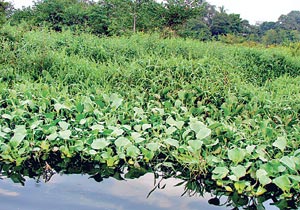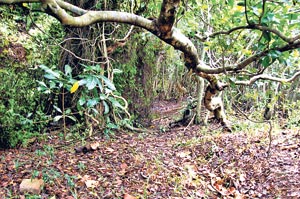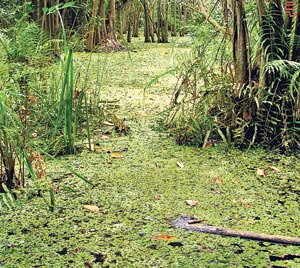Rains wreaked havoc in Colombo in the past few weeks, especially last week, flooding homes and roads, with water-levels knee-high or even chest-high.
Not only torrential rains but even a small shower leaves some parts of Colombo and other urban areas under water. What has gone wrong?
Urban wetlands have gone awry, the Sunday Times understands, not performing their crucial task of acting as flood detention areas and also others such as water draining, being a waste-water sink, replenishing ground water and purification of water.
“We need to take a long hard look at the urban wetlands,” urges Missaka Hettiarachchi of the Department of Chemical and Process Engineering, University of Moratuwa, who studied the Kolonnawa wetland in 2008, explaining that not one but all the urban wetlands should come under the microscope.
For, the urban wetlands which include swamps, marshes, estuaries, bogs and similar areas are not doing what they should and we need to find out why, he says, pointing to the “unseen” threat which is slowly but surely making them disappear with disastrous consequences.
The threat, it is learnt, is nutrient enrichment which fuels the rapid spread of invasive species, both plant and animal. There is a chain reaction -- when nutrient enrichment goes beyond a tipping point, the wetland’s capacity to perform its duties and functions reduces very fast and many eventually change to non-wetlands altogether.
 |
| The marsh vegetation is dominated by grasses and sedges. |
 |
| Ultimate conversion to non-wetlands with hard ground. |
“Pollution is one of the main culprits,” stresses Mr. Hettiarachchi, explaining that it occurs with the dumping of sewage, household waste-water and creation of small garbage dumps on the wetland.
Some of the “highly urban” wetlands in the country include the Bellanwila-Attidiya marshes, the Bolgoda wetlands, the Colombo flood detention area, the Muthurajawela marshes, the Negombo estuary and Gregory’s Lake in Nuwara Eliya while the “moderately urban” include the Mundel lake; the Arugam, Batticaloa, Jaffna, Koggala and Pottuvil lagoons; the Bentota, Madu Ganga and Puttalam estuaries and the Bundala National Park.
Although these have been identified in the National Wetlands Directory, there are a large number of smaller marshes, mangroves, lakes (like Kandy) and tanks (like Talangama) and fallow paddy lands which also need to be protected, he says.
Even though there is a good legal and policy framework in place, Mr. Hettiarachchi says it is vital to differentiate between “rural and natural” and “urban” wetlands because the traditional conservation oriented laws go well only with the first category.
Urban wetlands need special attention because there is huge pressure for development and the authorities may use these seemingly “idle” lands due to economic interests, he points out, explaining that in addition to filling up urban wetlands or using them as dumping grounds, the danger lies in releasing untreated sewage, both industrial and domestic waste and waste-water, which is easier than setting up a treatment plant or sanitary landfill.
So far, government-owned urban wetlands come under the strict protection of the Urban Development Authority or the Sri Lanka Land Reclamation and Development Corporation, but what of privately-owned wetlands or fallow paddy-land which are equally important but come only under the Agrarian Act which is basically focused on agriculture, he asks.
The polluting of such wetlands would lead to nutrient enrichment followed by the increase in invasive species. “It adversely affects the ‘water services’ offered by the wetland. For example changes in the community structure of vegetation can lead to changes in its hydrology and decrease the flood detention capacity,” says Mr. Hettiarachchi, explaining that a breakdown in flood detention and drainage services may lead to an increase in urban disasters such as floods.
 |
| Areas converted to thick shrub groves dominated by pond apple or wel atha |
At the same time, while dealing with the unseen threats, the more visible dangers such as direct filling and illegal encroachment should not be underestimated, as a huge extent, yet to be ascertained, of urban wetlands is lost per year due to these reasos, it is learnt.
Urban wetlands, in contrast to their rural/natural cousins should also be actively managed to get the desired level of services from them. The conservation-based thinking that an eco-system will be protected to the extent it is made out of bounds for human use will not apply to urban wetlands as they are an integral part of the urban process. This is why they have to be looked after and maintained as any other component such as sewers, drains, roads or parks, he points out.
“There should also be no ‘assumed benevolence’ towards urban wetlands on the part of those living in these areas – what is needed is a very personal interest in safeguarding the urban wetlands because they have an impact on your life,” adds Mr. Hettiarachchi.
Kolonnawa reveals all
The case study of the Kolonnawa marsh had revealed a very high spread of invasive species both plants and fish.
“In the marsh plots investigated an average 45% (nearly half) of the species found were invasive. The same trend was observed with fish. The highly-polluted areas of the waterways had very low fish-diversity and 100% of the fish found in these areas were exotic highly invasive varieties like the kissing gourami, thilapia and the knife fish,” said Mr. Hettiarachchi.
The study had also brought to light a steady increase in Ammonia, a prominent form of N, from 2000 to 2005. Phosphates had also been identified as a prominent pollutant in the wetland system. Both N and P had been were significantly above the levels recomended for healthy ecosystems, both in the water and the soil of the Kolonnawa marsh.
During the social survey of the marsh, it had been found that most households were unaware about proper management of wastewater and solid waste. Although almost 100% of the households within the vicinity of the marsh had sanitation coverage, most of the toilet pits, due to incorrect design, contributed to nutrients getting into the marsh.
“People as well as builders lacked proper technical knowledge on latrine construction,” said Mr. Hettiarachchi, who was the lead researcher of the study team which came under the supervision of Prof. Ajith de Alwis.
Usually the adverse environmental impact of people on the ecosystem emerges after a while, but Kolonnawa was a good lesson. There was a spiral impact of channelling sewage and waste-water to the marsh, with 60% of the households being directly affected by floods and 30-35% by water-related diseases within the three years preceding the survey.
The Kolonnawa study was funded by the International Foundation of Science, the University of Moratuwa and the Network for Women Water Professionals Sri Lanka. Technical support was provided by the Department of Zoology, University of Colombo, the Sri Lanka Land Reclamation and Development Corporation and Prof. R.B. Mapa of the University of Peradeniya.
Currently, the research team is in the process of establishing a resource centre and a website on the urban environment in Sri Lanka to encourage similar research. |




